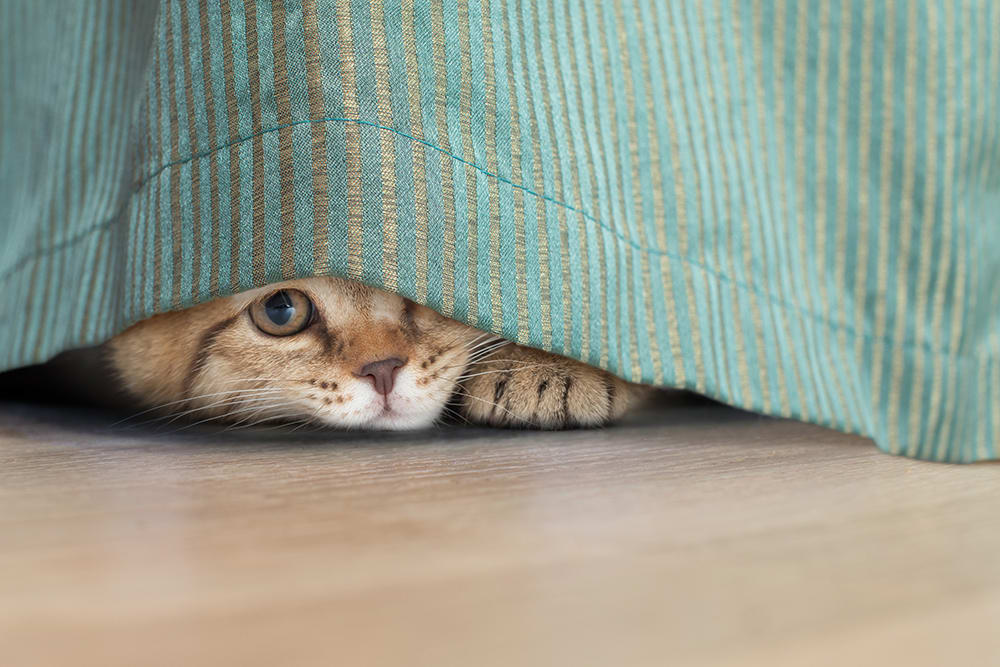How To Tell If a Cat is in Pain
Signs that a cat is in pain vary depending both upon the personality of the cat and the type of pain they are experiencing.
Most cats will show obvious signs of acute pain if they have an accident or injury but it can be much more challenging to tell if your cat is experiencing chronic pain such as pain caused by arthritis or gum disease.
Because cats instinctively hide signs of pain it is essential for pet parents to always keep a watchful eye for uncharacteristic behavior, personality changes, an unusual stride, or changes in appetite.
Signs That a Cat is in Pain
If your kitty is experiencing pain you may notice one or more of the following symptoms:
- Frequent or ongoing meowing or howling
- Litter box accidents, urinating outside of their litterbox
- Tail flicking
- Won't eat or reduced appetite
- Poor grooming, scruffy looking
- Reduced energy, lethargy or lack of interest in play or going outside
- Hiding, no interest in spending time with you or other family members
- Limping
- Avoiding being handled, picked up or petted
- Behavioral changes such as refusing to jump onto a bed or furniture that they typically love to be on
- Irritable mood, short tempered with people or other pets including
- Uncharacteristic hissing, growling or spitting
- Unusual vocalizations (meowing more than usual, crying)
- Excessive grooming
- Panting
- Patchy fur
Posture & Body Language Changes That Could Mean Your Cat is in Pain
Cats in pain will often display changes in body language. In some cases, the body language changes of a cat in pain will be very noticeable but often times these changes are more subtle. Our vets recommend always monitoring your cat's overall demeanor, stance, and gait so that any changes from their normal will be easily spotted.
- Body language changes related to pain in cats include:
- Tense looking body
- Crouched or being hunched over
- Head lowered
How Pain Could Be Expressed in Your Cat's Face
While many cats show little or no change in their facial expression while experiencing pain, some cats are very expressive. If your cat is in pain they might:
- Squint or close their eyes tightly
- Flatten their ears so that they are pressed to the sides or back of their head
- Project an overall facial appearance of tension with a tight mouth
When To Seek Veterinary Care For a Cat In Pain
Often signs of pain in cats are missed until the cat's condition is advanced. When it comes to your cat's long-term health it's always best to err on this side of caution.
If your feline friend is displaying signs of pain contact your vet right away to schedule an examination, or visit your local after-hours animal hospital. To help preserve your cat's good quality of life pain management, and treatment of painful conditions early are essential.
Note: The advice provided in this post is intended for informational purposes and does not constitute medical advice regarding pets. For an accurate diagnosis of your pet's condition, please make an appointment with your vet.
If your cat is displaying any symptoms or behavioral changes that give you cause for concern, contact our Clemmons vets right away. Our vets can diagnose your kitty's condition and provide you with effective treatment options quickly.
Looking for a vet in
Clemmons?
We're always accepting new patients, so contact our veterinary hospital today to book your pet's first appointment.
Related Articles View All
How often do you take a cat to the vet?
Regular checkups including vaccines and parasite control play a key role in helping your kitty achieve a long and healthy life. So, how often should you take a cat to the vet? Today we share general guidelines recommended by most veterinarians.
Exploring Cat Dental Health - Gingivitis
Is your cat refusing to eat, or losing weight? It could be due to a dental health problem such as gingivitis. Read on to learn about the signs and how gingivitis in cats can be treated.
The Best Way to Travel With a Cat
Planning a trip away from home and want to take your feline friend along with you? Here are a few helpful tips from our Clemmons team to help make the journey an enjoyable experience for both you and your cat.
Kitten First Vet Visit - What to Expect & What it Will Cost
Have you welcomed a beautiful new kitten into your heart and home? If so, early veterinary care can help to set your tiny fur baby on the path to excellent life-long health. Today, our Clemmons vets discuss kitten first vet visits.
How to Tell if Your Cat Has a Broken Leg
Regardless of whether your cat is a curious outdoor explorer or a chilled-out homebody, accidents can happen. Today, our Clemmons vets share signs that may indicate that your cat has a broken leg, and what you should do.

